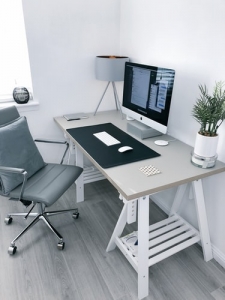by Lynn Roberts
As the COVID-19 pandemic continues into the fall of 2020, workers across Canada & the USA  resign themselves to a fact.
resign themselves to a fact.
They may be working from home for a lot longer than originally anticipated.
At this point, it’s anyone’s guess when most companies will send their teams back to work.
Many tech giants like Microsoft, Facebook, Twitter and Google are now saying they are in no rush to get their teams back in the office.
These companies were some of the first to send them teams home, and experts are saying they will likely be some of the last to bring them back in.
Some people may have a great setup for their at-home office.
Others, however, may be struggling to have a system that is comfortable and set up to prevent injury and repetitive strain.
It is critical that companies do their part to ensure their employees know how to set up a proper workspace.
This setup should serve their teams well & support their health over the long term.
To ensure your work from home space is ergonomically correct, follow the steps below:
1. Setting up your Computer
Do you use a laptop computer?
Laptop computers are typically quite terrible for ergonomics.
The fact that the screen and keyboard are connected means it’s very easy for portability when working from home, but it can cause stress and strain.
With a laptop computer, we tend to round our backs, hunch our shoulders and bend our necks down.
If you must work from home with a laptop, consider purchasing an external keyboard or monitor.
The important thing is to be able to raise your monitor height to eye level.
This will prevent neck strain from looking down and bending forward.
If you’re using an external keyboard with your laptop, consider propping your laptop computer up with some books to make the monitor portion high enough.
Experts also recommend avoiding eye strain by making sure your screen is about arm’s length away from your eyes.
Eye strain is typically caused by the muscles of the eyes over working and trying to maintain focus.
It can lead to headaches, eye dryness & fatigue.
Give your eyes a break too.
About every 20-30 minutes, experts recommend looking away from your monitor and taking a break.
You can also try one of our recommended eye exercises to reduce eye strain and soothe tired eyes.
2. Your Chair
Most of us naturally tend to slouch forward when we sit in our work chairs.
This can lead to compression in our backs, predominantly our lower backs, which then causes pain and muscle fatigue.
Ideally your chair will offer some type of lumbar support, to keep the natural curve in your back.
Most chairs cause us to unnaturally “flatten” this lumbar curve.
If you don’t have a chair with this level of support, you can place a rolled up towel or cushion between your lower back and your chair.
It’s important to keep this lumbar curve intact.
Additionally, we want to avoid carpal tunnel syndrome, which is caused by repetitive strain or prolonged pressure on parts of the body like our wrists or elbows.
To prevent carpal tunnel syndrome, keep your elbows at a 90 degree angle.
Keep your forearms parallel to the ground and your wrists in the optimal position (not too low, not too high).
3. Your Desk
If you are fortunate enough to have a desk that you can use while working  from home, it’s important to purchase a desk that is large enough to support your equipment.
from home, it’s important to purchase a desk that is large enough to support your equipment.
If you don’t have a desk, you can use your kitchen table, which is the next best alternative.
The height of your desk is critical.
What’s most important is to ensure your desk is at a height where your wrists are comfortably resting on the desk.
Your elbows should also be maintained at a 90 degree angle; they should be at the same height as your table.
If you need to be higher up, consider placing a cushion or pillow on top of your chair.
GENERAL TIPS
Avoid working anywhere but your desk, whenever possible, especially your bed, the floor, lying on the couch etc.
Remember to take frequent breaks.
Go for a walk, preferably out in nature.
Take a break to drink some water or have a light snack.
If you have stairs in your home, go up and down the stairs a few times to promote blood flow & boost oxygen levels.
And don’t forget to stretch frequently and do a few minutes of Chair Yoga to prevent injuries, reduce stress and tension and keep your body limber and fit.
